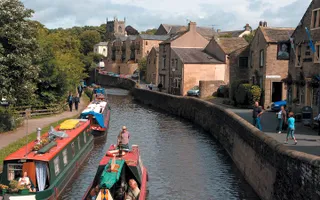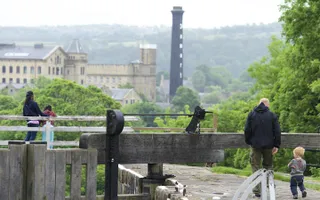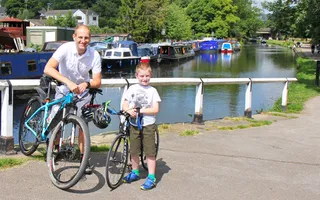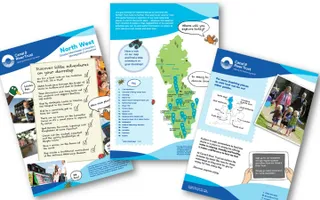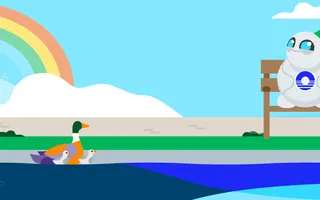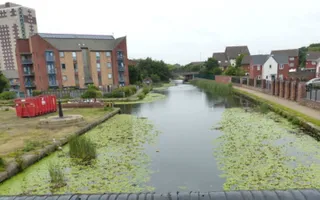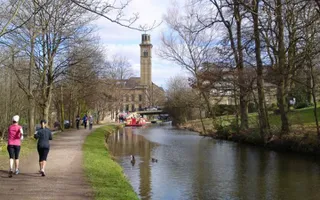Our team of experts work hard to ensure this 200 year-old canal continues to be a well-loved link between the bustling cities of Liverpool and Leeds.
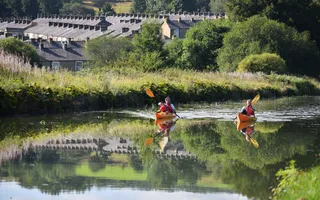
Leeds & Liverpool Canal
The Leeds & Liverpool Canal offers 127 miles of walking, boating, wildlife-watching and all-round relaxation.
The Leeds & Liverpool Canal was built to link the cities of Leeds and Liverpool. No other canal has been established and built to link two cities that were further apart. Leaving Liverpool, the canal passes through East Lancashire and then crosses Pennine countryside and picturesque villages on the edge of the Yorskhire Dales before reaching Leeds. Walkers love the canal, and thousands of visitors come every year to marvel at the impressive Bingley Five Rise Locks and the historic salt town of Saltaire.
Places to visit
See our free guides for fantastic family days out along the Leeds & Liverpool Canal:
- Leeds City Centre waterfront
- Liverpool's Royal Albert Docks
- Saltaire's World Heritage Site
- Bingley Five Rise Locks
- The pretty canalside town of Skipton
- The famous 'pier' at Wigan
- The Rufford Junction at Burscough
Walking, cycling and canoeing on the Leeds & Liverpool Canal
Local to you
Show me places within...
Explore your nearest canals and ways to enjoy them Find walks, activities and more within:
The history
Northern trade and industry flourished in the mid-18th Century, and there was great call for a canal linking the east and west of England.
The Leeds & Liverpool Canal was the earliest of the trans-Pennine canals to be proposed. It offered a gentler, less direct route than the Huddersfield Narrow Canal and the Rochdale Canal, but it still passed through important limestone and coal mining areas. Construction took a long time, two canals, one in Yorkshire and one in Lancashire, were gradually brought together and it was only completed in 1816, some 46 years after work began.
Together with the Aire & Calder Navigation, which it meets at Leeds, it offered a coast to coast route between the Irish Sea and the North Sea, though not a proper connection until the Stanley Dock branch in Liverpool opened in 1846.
The tunnel at Foulridge was opened in 1796. A tale that has passed into local folklore tells of the cow that fell into the water and swam the whole length of Foulridge Tunnel before being pulled out at the other end and revived with brandy.
Canal hey day
Locks on the Leeds & Liverpool Canal were for the most part built to a size of 62 feet by 14 feet (18.8m x 4.3m). These broad locks turned out to play a key part in the long-term success of the Leeds & Liverpool Canal. The local cargo craft were known as 'short boats', broad-gauge vessels capable of carrying around 45 tons. The larger payload of the short boats - around twice that of a standard narrowboat - enabled the line to prosper for many years.
The canal's most important cargo was coal closely followed by merchandise. Thanks to the combination of local heavy industry and the decision to build the canal with broad locks, the Leeds & Liverpool was able to compete successfully with the railways throughout the 19th Century. It even remained open for much of the 20th Century, other than household coal which is still being moved today, the last cargo of coal was carried along the Leigh Branch to Wigan Power Station in 1972. However other cargoes were carried after that, around 10,000 tonnes in all, until 1982.
The canal was so successful that the reservoirs built to supply the canal were never adequate, with water shortages in dry summers. Despite this, the canal continued to carry large tonnages well into the 1950s.
World War II
The Leeds & Liverpool Canal, like several major waterways across the country, formed part of Britain's defense plans against foreign invasion. Today, you can still see some remaining concrete pill boxes and blockhouses in west Lancashire. In this area, even canalside buildings such as pubs and barns were fortified.
Decline of commercial traffic
Traffic began to dwindle on the Leeds & Liverpool Canal with the introduction of natural gas and subsequent closure of the canalside collieries.
In the 1950s and 1960s, waterway enthusiasts including members of the Mersey Motor Boat Club tried hard to keep the canal open and navigable using a wide variety of boats, including converted life boats.
The Leeds & Liverpool Canal today
The Leeds & Liverpool Canal has continued to flourish in the 21st Century. The Ribble Link, which opened in 2002, allows the Leeds & Liverpool to connect with the Lancaster Canal and opened up a number of cruising opportunities for boaters. You need to book your passage through the Ribble Link so see that page for details.
And following the £22 million creation of the Liverpool Canal Link, the Leeds & Liverpool Canal now extends right into the heart of Liverpool and its historic Royal Albert Dock.
We're delighted that this historic waterway, once so vital to the manufacturing industries of the north, is continuing to play an important role in this second age of the canals.
Where does the water come from?
Gargrave to Leeds
The Yorkshire length of the Leeds & Liverpool canal from below Gargrave Locks, to Leeds at the beginning of the Aire and Calder Navigation, is supplied by feeders - diverted tributaries of the River Aire. Some water also comes from the canal summit, supplied by reservoirs which collect rainwater in the Pennines. The nearest reservoir is Winterburn, from where water is piped 8 miles to the canal summit.
Feeders supply the Yorkshire side of the Leeds & Liverpool at Eshton Beck, Eller Beck, Middle Beck (Bradley), Morton Beck, Bingley 5 Rise, and Whitfield Mill.
Gargrave to Wigan
The Lancashire section of the Leeds 6 Liverpool Canal from Gargrave Locks to Wigan is supplied by reservoirs which collect rainwater in the Pennines. The most northern reservoir is Winterburn, from where water is piped 8 miles to the canal summit. Summit water also comes from Upper Foulridge, Lower Foulridge, Slipper Hill and Whitemoor Reservoirs.
Barrowford and Rishton Reservoirs supplement the supply on the southwest side of the summit.
Barrowford Reservoir is filled only with surplus water from the summit pound, ensuring that we don't waste water. Small feeders (diverted streams) flow into the canal and augment the water supply.
Central section
The highest section of the Leeds 6 Liverpool Canal including Gargrave, Bank Newton, Greenberfield and Barrowford locks, is supplied by reservoirs which collect rainwater in the Pennines. The most northern reservoir is Winterburn, from where water is piped 8 miles to the canal summit. Summit water also comes from Upper Foulridge, Lower Foulridge, Slipper Hill and Whitemoor Reservoirs.
Reservoirs and feeders are dependent on rainfall to keep them supplying water to the canals all year round. When, from time to time, these resources are not sufficient to support the canal, drought measures e.g. restrictions may need to be applied. Restrictions make water use at locks more efficient, and allow the canal to refill overnight, preventing boats from grounding. The Trust carefully monitors the situation to minimise disruption to boaters and the environment.
Johnson's Hillock
Johnson's Hillock is a flight of seven locks on the Leeds 6 Liverpool Canal. It is supplied by summit reservoirs in the Pennines. The biggest summit reservoir is Winterburn from which water is piped eight miles to the canal summit above Greenberfield Locks. Upper and Lower Foulridge, Slipper Hill and Whitemoor Reservoirs also feed the canal summit.
Barrowford and Rishton reservoirs supplement the supply on the south-west side of the summit.
Barrowford reservoir is filled only with surplus water from the summit pound, ensuring that we don't waste water.
Many feeders (diverted streams) flow into the canal and augment the water supply.
Leeds Lock
Leeds Lock is the first lock on the Aire & Calder Navigation and is fed by the River Aire (flowing in under Leeds Station) and the Leeds & Liverpool Canal. This section of the Leeds & Liverpool Canal is supplied by feeders - water diverted from tributaries to the River Aire. Sorne water also comes from reservoirs on the canal summit, over 30 miles away.
The navigation allows large commercial craft to reach Goole in the east; Wakefield and Rotherham to the south; York via the River Ouse in the north; Nottingham via the River Trent; and out to sea via the Humber Estuary. The River Aire has a catchment area of 800km² which is 51% of South Yorkshire.
Stanely Locks
Seven reservoirs can supply water to Stanley Locks. Five of these directly supply the Leeds & Liverpool Canal summit. The other two supply the 21 mile pound between Barrowford & Blackburn lock flights.
It is 57 miles as the crow flies from the furthest summit reservoir (Winterburn) to Stanley Locks.
In Wigan Scholes Feeder adds water from the River Douglas. The Leigh Branch is also supplied through its junction here.
At Appley Bridge Lock, Gathurst Feeder adds more water from the River Douglas. The Rufford Branch also takes its water from this pound.
All the lockage water used on the Leigh Branch goes into the Bridgewater Canal. Stanely Locks link the Leeds & Liverpool Canal to the Mersey Docks system. The Rufford Branch link the Leeds & Liverpool and Lancaster Canals via the Rivers Douglas and Ribble.


Stay connected
Sign up to our newsletter and discover how we protect canals and help nature thrive


